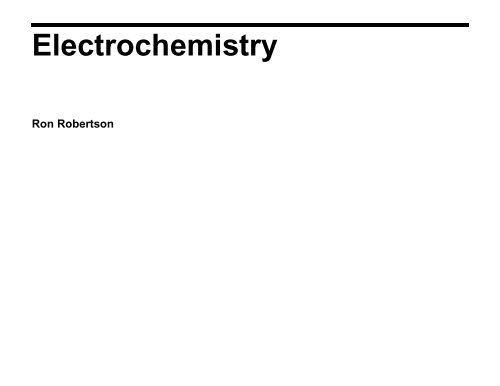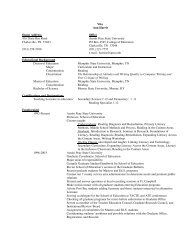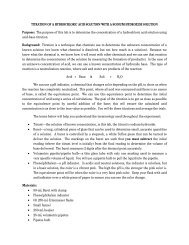Electrochemistry
Electrochemistry
Electrochemistry
You also want an ePaper? Increase the reach of your titles
YUMPU automatically turns print PDFs into web optimized ePapers that Google loves.
<strong>Electrochemistry</strong><br />
Ron Robertson
I. Applications of Redox Reactions<br />
A. Terminology<br />
Zn (s) + Cu +2 (aq) fi Zn +2 (aq) + Cu (s)<br />
This reaction is redox because electrons have been transferred.<br />
Oxidation - loss of electrons, ox # increases, Zn fi Zn +2<br />
Reduction - gain of electrons, ox # decreases, Cu +2 fi Cu<br />
Reducing agent - agent that allows reduction to occur, it is the<br />
substance that is oxidized and can provide electrons<br />
Oxidizing agent - agent that allows oxidation to occur, it is the<br />
substance that is reduced and takes the electrons provided.<br />
B. Examples<br />
Corrosion<br />
Combustion<br />
Metabolism<br />
Voltaic cells (batteries)<br />
Electrolysis<br />
<strong>Electrochemistry</strong> Slide 1
B. Balancing Redox Reactions<br />
Oxidation reduction reactions are sometimes very difficult to<br />
balance. Mass, charge, and # of electrons must be<br />
balanced. The following method for balancing is slightly<br />
different from the book.<br />
1. Write reaction in ionic form and assign oxidation numbers<br />
2. Separate into half cells<br />
3. Balance # of atoms of oxidized and reduced species<br />
4. Balance # of electrons of oxidized and reduced species<br />
5. Make sure electrons lost in the oxidation = electrons gained<br />
in the reduction<br />
6. Balance charge in each half cell using H + if in acid and<br />
OH - if basic<br />
7. Balance # of H and O using water molecules.<br />
<strong>Electrochemistry</strong> Slide 2
II. Voltaic cells (Batteries)<br />
A. Theory of operation<br />
Zn(s) + Cu +2 (aq) fi Zn +2 (aq) + Cu(s)<br />
This does not look like a battery because the electrons are<br />
being transferred directly between Cu +2 and the Zn strip.<br />
If we separate the reactions and force the electrons to<br />
travel through a circuit we could use these electrons as<br />
they try to get from the Zn to the Cu +2 .<br />
<strong>Electrochemistry</strong> Slide 3
The push of the electrons to go from Zn to Cu +2 is called<br />
the voltage.<br />
Voltage = work/charge V = W/Q<br />
Volt [=] Joule/coulomb<br />
This push can be measured with a voltmeter.<br />
Why do we need the salt bridge?<br />
In the figure above the electrons from Zn fi Zn +2 will<br />
move through the wire and over to the other side to the<br />
Cu +2 . Almost immediately the flow stops because of a<br />
charge buildup on both sides.<br />
<strong>Electrochemistry</strong> Slide 4
Zn +2 ions are accumulating in the left compartment (+)<br />
and Cu +2 ions are leaving on the right side (-). We must<br />
allow ions to flow to equalize the charge. This is the<br />
function of the salt bridge.<br />
With the salt bridge the circle is complete. Electrons flow<br />
through the wire from Zn to Cu +2 and anions move from<br />
the right side to the left and cations move from left side to<br />
the right to equalize the charge. This total movement of<br />
charge, ions in the internal circuit and electrons in the<br />
external, completes the voltaic cell.<br />
B. The notation for the cell is<br />
M (electrode)‰M + (solution)‰‰N + (solution) ‰N(electrode)<br />
anode<br />
cathode<br />
<strong>Electrochemistry</strong> Slide 5
C. Thermodynamics and the Cell Potential<br />
Standard Potential - When all reactants and products<br />
present are pure solid or in solution at 1.0 M (or gases<br />
at 1.0 Atm) the conditions are standard and the<br />
measured voltage is called the standard potential E .<br />
This E is a measure of the tendency of pure reactants to<br />
become products, sort of like DG o . There is a relationship<br />
between the two:<br />
Under standard conditions DG = -nF E<br />
Under any conditions DG= -nF E<br />
Since spontaneous reactions have a positive E there must<br />
be a negative sign in the proportionality. n represents<br />
the number of moles of electrons (also called<br />
Faradays) transferred in the balanced equation. F is a<br />
conversion between Joules, Volts and moles of<br />
electrons. It is called Faraday’s constant. F = 96,500<br />
coulombs/mole<br />
<strong>Electrochemistry</strong> Slide 6
D. Half Cell Potentials<br />
We can measure the push of electrons (called the voltage) through the<br />
external wire for a voltaic cell. This voltage can be envisioned as a sum of<br />
2 pushes - one for the oxidation and one for the reduction.<br />
E cell = E red + E ox<br />
The tendency for a metal to lose or gain electrons can be measured by<br />
these pushes - called the oxidation and reduction potentials. The larger<br />
the value the greater the tendency for that reaction to occur - or put<br />
another way the more positive the oxidation or reduction potential is the<br />
greater the tendency for that oxidation or reduction to occur.<br />
oxidation potential<br />
(E ox )<br />
reduction potential<br />
(E red )<br />
E ox = - E red<br />
M +x M +y + ze -<br />
M +y + ze - M +x<br />
<strong>Electrochemistry</strong> Slide 7
The problem is that we cannot measure each individual push so we<br />
cannot measure the absolute cell potential. So we define a cell potential<br />
to be zero and measure all others against it. This allows the calculation of<br />
all other potentials. The actual zero potential that has been agreed upon<br />
is the H 2 2H + + 2e - .<br />
E. Rules of thumb for using half cell potentials<br />
1. E values are normally tabulated as reduction<br />
potentials<br />
2. If you need to find the oxidation potential simply<br />
reverse the algebraic sign of E . All reactions are<br />
reversible<br />
3. The more positive the value of E is the more likely the<br />
process is to occur. Since the reduction process is the<br />
agent of oxidation, the elements at the top of the<br />
reduction table are the best ox agents and the species<br />
at the bottom (for the reverse oxidation reaction) are<br />
the best reducing agents.<br />
<strong>Electrochemistry</strong> Slide 8
4. Under standard conditions (1M or 1Atm) any<br />
substance will spontaneously oxidize any other<br />
substance underneath it in the reduction table.<br />
5. Potentials are intensive properties. Changing the<br />
stoichiometric coefficients for a half-rxn does not<br />
change the value of E.<br />
6. To predict the spontaneity of a rxn, add E of the red<br />
rxn and E of the ox rxn together. If E is positive the<br />
rxn is spontaneous under standard conditions.<br />
F. Example problems and questions using half cell<br />
potentials<br />
• Will aluminum dissolve in a solution of Sn +4 ?<br />
• Why do people who have dental fillings feel pain when<br />
chewing a piece of aluminum foil?<br />
• Predict the voltage of an aluminum/zinc battery.<br />
• Which is spontaneous, the reaction of iron with the<br />
cupric ion or the reaction of copper metal with<br />
ferrous ion?<br />
<strong>Electrochemistry</strong> Slide 9
G. Voltaic cells at nonstandard conditions<br />
What if the concentrations are not 1 M for all ions? The<br />
Nernst Equation relates the cell potential to the<br />
concentrations of the ions.<br />
E = E - [RT/nF] ln Q<br />
Q is the reaction quotient, the ratio of product<br />
concentrations divided by reactant concentrations. Since<br />
this equation is a holdover from the days when log 10 was<br />
easier to compute than natural log the equation became<br />
E = E - [RT/nF] 2.303 log Q<br />
Using R = 8.314 J/mole K, F = 96,500 coulombs /mole and<br />
T = 298 K (most reported data) the equation finally<br />
becomes<br />
E = E - [0.0592/n] log Q<br />
<strong>Electrochemistry</strong> Slide 10
When equilibrium is reached E = 0 V and the reactions<br />
quotient Q equals the equilibrium constant K. This<br />
gives an expression relating the equilibrium constant<br />
to the E of the cell.<br />
log K = n E /0.0592<br />
Example:<br />
Find the cell potential for the reaction of an iron strip<br />
with Cd +2 ion if the concentration of ferrous ion is 1.0 M<br />
and the concentration of the cadmium ion is 0.010 M.<br />
Fe(s) + Cd +2 (aq) fi Fe +2 (aq) + Cd (s)<br />
<strong>Electrochemistry</strong> Slide 11
H. Common Batteries<br />
1. Dry Cell (1.5 V)<br />
Anode Zn fi Zn +2 (aq) +2e<br />
Cathode 2NH + 4 + 2e fi 2NH 3 (g) + H 2 (g)<br />
The hydrogen gas is a problem so MnO 2 is added; gaseous<br />
ammonia reacts with the Zn +2 ion.<br />
• decline in voltage under high load<br />
2. Alkaline (1.54 V)<br />
Anode Zn(s) + 2OH - (aq) fi ZnO(aq) + H 2 O + 2e<br />
Cathode 2 MnO 2 (s) + H 2 O + 2e fi Mn 2 O 3 (s) + 2OH - (aq)<br />
no gases are formed<br />
• no decline in voltage under high load<br />
<strong>Electrochemistry</strong> Slide 12
3. Lead storage (2.04V)<br />
Anode Pb (s) + SO -2 4 (aq) fi PbSO 4 (s) + 2e<br />
Cathode PbO 2 (s) + 4 H 3 O + + SO -2 4 (aq) fi PbSO 4 (s) + 6H 2 O<br />
Net reaction<br />
Pb + PbO 2 + 2H 2 SO 4 fi 2PbSO 4 + 2H 2 O<br />
These reactions are just a little different than the text.<br />
• can be recharged because the lead (II) sulfate product is<br />
an insoluble product which stays at the electrodes.<br />
4. Nickel/Cadmium (1.3 V)<br />
Anode Cd(s) + 2OH - (aq) fi Cd(OH) 2 (s) + 2e<br />
Cathode NiO 2 (s) + 2H 2 O + 2e fi Ni(OH) 2 (s) + 2OH - (aq)<br />
• can be recharged due to the fact that products are<br />
insoluble hydroxides that stay at the electrode surface<br />
• this battery produces a constant voltage until<br />
completely discharged<br />
<strong>Electrochemistry</strong> Slide 13
I. Fuel Cell<br />
a special type of voltaic cell in which the reactants are<br />
continually supplied from an external source; the best<br />
known is the hydrogen / oxygen fuel cell used in the space<br />
program<br />
anode 2H 2 (g) + 4 OH- (aq)fi 4 H 2 O (l) + 4e<br />
cathode O 2 (g) + 2 H 2 O (l) +4e fi 4OH - (aq)<br />
An explosion does not occur because the reaction is<br />
carried out at low temperature on a platinum catalyst.<br />
The net cell reaction is simply the production of water.<br />
<strong>Electrochemistry</strong> Slide 14
III. Corrosion<br />
A. Defined as the oxidation of a metal that results in a<br />
loss of structural strength and that is a result of<br />
exposure to the environment.<br />
The most common is the corrosion of iron (rusting).<br />
Many metals oxidize but only those which form scaly<br />
oxidize coatings corrode. For example aluminum oxidizes<br />
readily but does not corrode easily.<br />
B. Reactions for rusting<br />
Anode Fe(s) fi Fe +2 + 2e<br />
Cathode O 2 (g) + 2 H 2 O (l) + 4e fi 4OH - (aq)<br />
This gives the net reaction<br />
2Fe(s) + O 2 (g) + 2H 2 O(l) fi 2Fe(OH) 2 (s)<br />
Further reaction with oxygen gives the red-brown<br />
hydrated iron (III) oxide - Fe 2 O 3 • H 2 O (s)<br />
<strong>Electrochemistry</strong> Slide 15
C. Requirements<br />
• Anodic areas occur at cracks in the metal surface<br />
exposing pure metal.<br />
• Cathodic areas can be anywhere else on the metal.<br />
• Water is a necessary ingredient to form a salt bridge<br />
between anode and cathode.<br />
• Chlorides dissolved in the water such as salt speed up<br />
corrosion by enhancing the salt bridge.<br />
D. Protection<br />
Anodic inhibition - coat the surface of the metal to<br />
prevent exposure. More recent treatments involve<br />
chromate baths to form a tight film of iron and<br />
chromium oxides on the surface.<br />
<strong>Electrochemistry</strong> Slide 16
Cathodic protection - force the metal to become a cathode<br />
instead of the anode. This is accomplished by<br />
attaching a more readily oxidized metal, such as zinc,<br />
to the metal being protected. The iron is said to be<br />
galvanized. A current example is the dipping of the<br />
steel frame of a car in a solution of zinc phosphate to<br />
prevent corrosion.<br />
<strong>Electrochemistry</strong> Slide 17
IV. Electrolysis<br />
A. This is the opposite process from the galvanic cell.<br />
We use an electric current to force a nonspontaneous<br />
reaction.<br />
Cell Electrode Function Polarity<br />
Battery Anode oxidation negative<br />
Cathode reduction positive<br />
Electrolysis Anode oxidation positive<br />
Cathode reduction negative<br />
B. Applications<br />
1. Production of elements such as sodium and chlorine<br />
2. Plating of metals over another metal (or suitably<br />
prepared substance) for protection or beauty<br />
<strong>Electrochemistry</strong> Slide 18
C. Predicting reactions<br />
1. Molten NaBr<br />
Anode (ox) 2 Br- fi Br 2 + 2e -1.09 V<br />
Cathode (red) Na + + e fi Na(s) -2.714 V<br />
______________________________________<br />
2Br - + 2 Na + fi 2 Na + Br 2<br />
A battery with a voltage of 3.8 V or greater must be used.<br />
2. An aqueous solution of NaBr<br />
Possible anode reactions<br />
2 Br- fi Br 2 + 2e -1.09 V<br />
6H 2 O fi O 2 + 4H 3 O + + 4 e -1.229 V<br />
Possible cathode reactions<br />
Na + + e fi Na(s) -2.714 V<br />
2H 2 O + 2e fi H 2 + 2 OH - -0.8277 V<br />
Choose the reactions that are the most positive to get<br />
2 Br - + 2H 2 O fi Br 2 + H 2 + 2OH -<br />
<strong>Electrochemistry</strong> Slide 19
D. Electrical Energy Use<br />
• 1 mole of electrons (a Faraday) will give 1 equivalent<br />
of material in an electrolysis reaction<br />
• 1 equiv = molar mass/ # of mole of e transferred<br />
• 1 amp of current = 1 coulomb of charge/sec<br />
These relationships give the following equation for the<br />
calculation of the mass (m) of material produced at an<br />
electrode<br />
m = MIt<br />
νF<br />
m [=] g<br />
M[=] g/mole<br />
I[=]amps or coulombs/s<br />
t[=] seconds<br />
F[=] 96,500 coulombs/mole<br />
n[=] no units, it is equal to the number of moles of<br />
electrons transferred in the half reaction<br />
<strong>Electrochemistry</strong> Slide 20
Examples<br />
In a commercial operation of sodium by the electrolysis of<br />
NaCl the cell operates at 7.0 V and a current of 25 x 10 3<br />
amps. How many g of sodium can be produced in 1 hour?<br />
A current of 0.015 amps is passed through a solution of<br />
Cu(NO 3 ) 2 for 155 minutes. What mass of copper is<br />
deposited at the cathode?<br />
<strong>Electrochemistry</strong> Slide 21

















